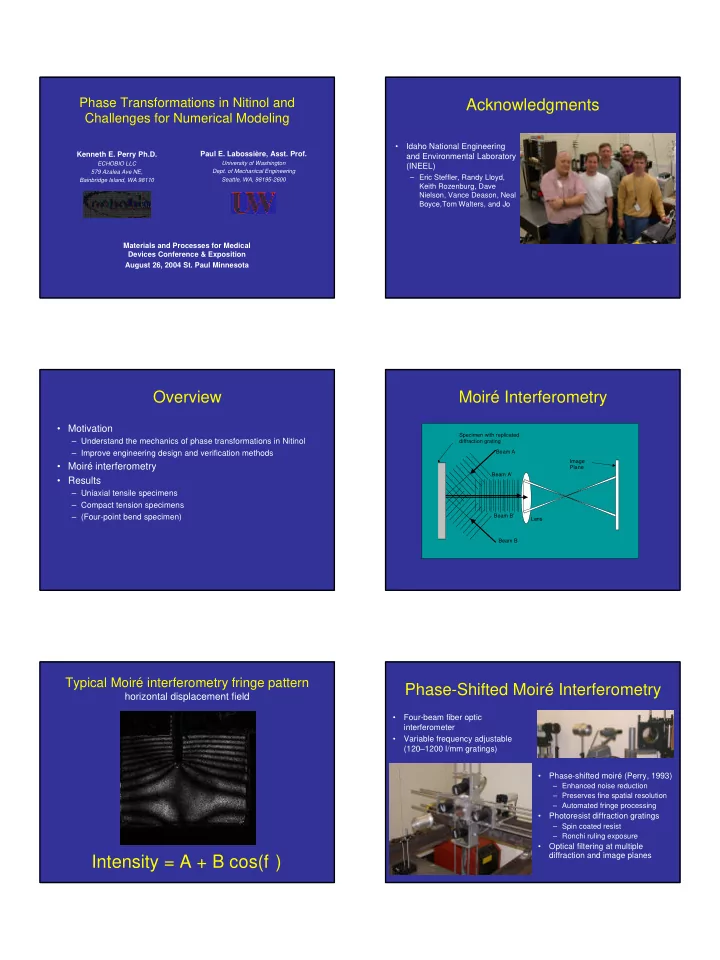

Phase Transformations in Nitinol and Acknowledgments Challenges for Numerical Modeling • Idaho National Engineering Paul E. Labossière, Asst. Prof. Kenneth E. Perry Ph.D. and Environmental Laboratory ECHOBIO LLC University of Washington (INEEL) Dept. of Mechanical Engineering 579 Azalea Ave NE, – Eric Steffler, Randy Lloyd, Seattle, WA, 98195-2600 Bainbridge Island, WA 98110 Keith Rozenburg, Dave Nielson, Vance Deason, Neal Boyce,Tom Walters, and Jo Materials and Processes for Medical Devices Conference & Exposition August 26, 2004 St. Paul Minnesota Overview Moiré Interferometry • Motivation Specimen with replicated – Understand the mechanics of phase transformations in Nitinol diffraction grating – Improve engineering design and verification methods Beam A Image • Moiré interferometry Plane Beam A’ • Results – Uniaxial tensile specimens – Compact tension specimens – (Four-point bend specimen) Beam B’ Lens Beam B Typical Moiré interferometry fringe pattern Phase-Shifted Moiré Interferometry horizontal displacement field • Four-beam fiber optic interferometer • Variable frequency adjustable (120–1200 l/mm gratings) • Phase-shifted moiré (Perry, 1993) – Enhanced noise reduction – Preserves fine spatial resolution – Automated fringe processing • Photoresist diffraction gratings – Spin coated resist – Ronchi ruling exposure • Optical filtering at multiple diffraction and image planes Intensity = A + B cos(f )
Phase Shifting and Unwrapping Examples of Moiré fringe patterns at low load prior to onset of SIM transformation Horizontal displacement field Vertical displacement field f i I ij = A i + B i cos(f i + d j ) A i , B i , f i : data at each pixel dj: phase shift i: 1024x1024 pixels f i j: 1 to 5 phase shifts Effect of specimen grating thickness Uniaxial tensile specimens elevated load, near end of plateau • Superelastic Nitinol – A f = ~20 o C Material X – A f = ~5 o C Material Y • Two different processing histories • Dimensions – Width 1.25 mm – Thickness 0.4 mm – Gage section 10mm Moiré with epoxy grating Moiré with photoresist grating Comparison of Global Data and Moiré Interferometry Results Local Moiré Strain Measurements progressive loading of uniaxial tensile specimens (Material X) (Material X) 600 500 400 Stress [MPa] 300 200 100 0 0 0.02 0.04 0.06 0.08 Strain [mm/mm]
Comparison of Global Data and Moiré Interferometry Results Local Moire Strain Measurements progressive loading of uniaxial tensile specimens (Material Y) (Material Y) 800 600 ` ` ` ` ` ` ` ` ` ` ` ` ` ` ` ` ` ` ` Stress [MPa] ` ` ` ` 400 200 0 0 0.02 0.04 0.06 0.08 Strain [mm/mm] Compact tension specimens Moiré Interferometry Results low load, prior to SIM (30N) Compact Tension Samples – Superelastic Nitinol, A f = 25 o C – Longitudinal and transverse orientations – Dimensions • Notch size 500 µ m • Thickness 0.6 mm • Width 12.54 mm Moiré Interferometry Results Moiré Interferometry Results intermediate load, near first evidence of SIM (199N) partially unloaded (149N)
Moiré Interferometry Results Moiré Interferometry Results partially unloaded (149N), vertical displacement field four point bend experiment 2mm Summary Moiré Interferometry Results • Phase transformation in Nitinol is sub grain size (<10microns) and distributed • Lüders-type localization was seen in some uniaxial specimens, different behavior in other specimens • Transformation around stress concentrations follows repeatable, distributed patterns • Volume fraction of SIM increases with increasing load, even beyond the end of the plateau • Elastic strain decreases in the transformation zone during unloading and SIM persists until near complete unloading • No evidence of a SIM toughening mechanism, perhaps stress shielding and redistribution effects Conclusions • Phase-shifted Moiré is an excellent technique for studying Nitinol and enables better engineering design and verification methods • New material models should be developed which account for the observed distributed transformation behavior • We still have more to learn
Recommend
More recommend